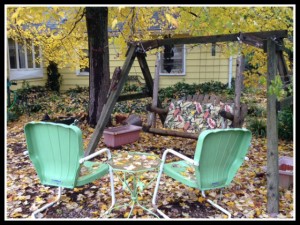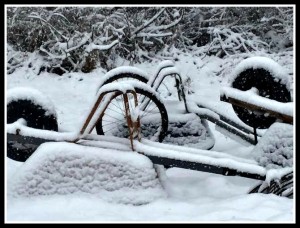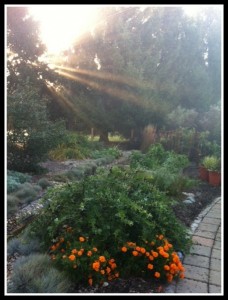It’s snowing today and quite windy, too, so it feels like winter. But this past weekend, the weather was warm enough — and dry enough — to sit outside in the garden. It usually isn’t warm enough to do that in January, but this year is different, compliments of El Nino.
I sat in the swing beneath the maple tree, where in summer a great canopy of shade cools the air below. On this particular rare bright day in a sea of cloudy days, however, only a tracery of branches studded with nascent buds reached to the blue above.
Home
For reasons having to do with my husband’s work moving temporarily to another state, we were away from the garden for several months. We made sure it was cared for during our absence, of course. We are back now, and eagerly looking forward to spring, as we always do at this time of year. However, knowing that spring is at least a couple of months away, I took the time to observe the garden in its dormancy. Here is what I noticed.
Green
I saw several colors, such as the bright blue of my bottle tree, which we moved to a more prominent location this year, and little bits of orange in now-empty plant supports. The most prominent color I saw, however, was green. Green — in January! Typically at this time of year, the color palette is white, gray, and black.
What’s green? We have a number of evergreens (not as many as I would like), which are various shades of green. Sedum Angelina, a ground cover, is bright green, and a couple of hardy herbs have kept their bluish-green color. A few rocks and the north side of the swing are growing moss, so they have a greenish cast that I find to be quite lovely. Our green-painted tuteurs and chairs blend in in summer. Not in winter, though. Then, they pop!
We had one significant snowfall this winter, back in November, when it snowed about six inches. The snow did not last long, melting completely away before Thanksgiving. Since then, we have had several light snows, enough to add a light coating to leaves and branches, but not enough to cover or insulate plants from the cold. So far we have had no frigid weather, but if a cold snap happens, it will likely be hard on some of the uncovered plants.
I took this photo on the morning of the snow and found myself looking at it more than once. It’s a surprising moment of serendipity for me. Even a collection of old wheelbarrows can be beautiful covered with snow!
Chores
From the vantage point of the swing, I could see a number of things that need to be moved, adjusted, repaired or added. (Don’t they always in a garden?) Here is a short. non-inclusive list:
- The bee house we made has not attracted bees as yet. We need to do something to fix that, but what? Add a shelter over the entrance, perhaps? Adjust its location?
- The clematis trellis has come loose from its upper mooring and needs to be refastened.
- The vegetable boxes have lain dormant for a year. They will need some dedicated care when spring arrives.
- Brown abounds. I want to add ground covers.
- A red-twig dogwood needs to be moved, as well as a grafted Japanese maple. These are daunting tasks!
- Most importantly — and even more daunting — are the ponds. They need to be redone. Water is so important to the ambiance of Serendipity Gardens, but I want to take this opportunity to naturalize the ponds more so that they will be less dependent on pumps! I am busy now looking for ideas on Pinterest and gently nudging my husband in the direction I want to go!
All this I saw, plus the routine work of weeding, deadheading, and general maintenance that lies ahead.
Love
My most important observation was this. Serendipity Gardens seems to have missed us almost as much as we missed it. It’s almost as though the garden knew its own people were absent. The people living here appreciated the garden, but they didn’t love it the way we do. They did not, for example, deadhead the flowers, or water the plants, or enjoy the volunteer cherry tomato that made itself known mid-summer. They had lots of parties on the patio but neglected the garden. Consequently, when we returned, despite regular weeding and other routine care, the garden looked a bit neglected and forlorn, a bit messy. To put it simply, it didn’t look loved. And that seemed to me, on this sunny winter day, a necessary component for a beautiful garden. Someone must love it.
That someone — or perhaps more than one someone — has to think about the garden and what it needs, walk in it, pull a weed here and deadhead a plant there, on a regular basis. Someone needs to notice when a plant needs a drink and provide it. Someone needs to pick the volunteer cherry tomatoes and pop them warm into the mouth for a delicious summer treat.
On this warmish winter day, when we have been back about three weeks and the woman who helps with the garden has put in extra hours, the garden looks loved again. I cannot exactly pinpoint the difference, but it’s there.
As it has always done, even in its most neglected moments, it loves us back. It gives us beauty and sweet fragrance. It provides the freshest air to breathe. It attracts birds, bees and butterflies as well as other creatures that entertain us. We get fresh, delicious food from it. The sough of the wind in the trees … how we missed it!
As always, the garden gives us plenty of work to do! I am more glad than I can say to be back. My husband feels the same.
Other Posts that Might Interest You
High Summer in Serendipity Gardens (for a look at the opposite season)
Six Cheap, Easy Things You Can Do to Help the Bees — Including How to Build a Bee Hotel
Like this post? Sign up to receive an email each time a new post is available. We will never loan, sell or rent your email address — that’s a promise! Please use the buttons below to share with others — and please comment. It’s nice to hear your thoughts.


